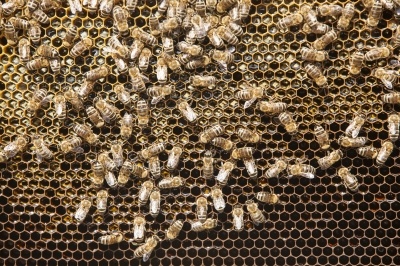
Most of us have at sometime been treated to eating honey, still with the beeswax in which it was first naturally contained. For those who are not familiar with beeswax, it is the honeycomb portion which is made by a worker honey bee (Apis mellifera L.) from special glands. Honeycomb made up of a complex mixture of waxes which are technically composites of saturated and unsaturated linear and complex monoesters, hydrocarbons, free fatty acids, free fatty alcohols, and other minor substances.
Beeswax is an important food additive where it is used mainly as a glazing agent for confectionary except chocolate. It is also used to coat patisserie and other baked goods when coated with chocolate, nuts, various snacks, coffee beans and even as a surface coating for fruit which helps protect them from decay and shrivelling up by reducing moisture loss. In the nutraceutical world, you will find beeswax as a food supplement and a carrier for certain types of colour. The level of addition follows the qauntum satis principle.
It is worth pointing out that beeswax has been used for centuries in all sorts of forms. Production of candles, for wax paper, polishing materials, medicines and wax for stamps have all been traditional uses. In Eastern Europe, beeswax is a traditional material for coating eggs and in most countries is a key component of cosmetics.
Regulations
The ingredient is identified in the European Union as E901. Its purity is specified in criteria laid down in EU Directive 96/77/EC. As well as the name beeswax, you might see it on the ingredient list as white or yellow wax. In the USA, beeswax of both colours has GRAS status. Here it is described as a flavour and adjuvant, lubricant and surface-finishing agent. When used in food the levels should not exceed good manufacturing practice as a multipurpose ingredient. Current use levels in food result in concentrations of 0.065% for chewing gum, 0.005% for confectioneries and frostings, 0.04% for hard candy, 0.1% for soft candy and 0.002% or less for all other food categories (CFR, 2003).
The CAS Registry number for both types is:-
8006-40-4 (yellow beeswax)
8012-89-3 (white beeswax)
The EINECS Number is 232-383-7
Beeswax is produced in its yellowish form by melting honeycomb from which all the honey is removed, in hot water and sieving to remove any foreign matter. Bleaching produced the white form.
Composition
Beeswax is a complex mixture of saturated and unsaturated linear and complex monoesters, hydrocarbons, free fatty acids, free fatty alcohols and other minor exogenous substances [see section 4.7] (Aichholz and Lorbeer, 1999).
More than 300 individual components have been reported in beeswax from various species of honeybees (Tulloch, 1980). Although their concentrations may vary depending upon the honeybee species and the geographical origin, only small differences are observed in the concentration of individual components and substance classes (Aichholz and Lorbeer, 1999; Wolfmeier et al., 1996).
A total content of 27 to 40% monoesters, 9 to 23 % hydroxymonoesters, 7 to 16% diesters, 3.9 % hydroxydiesters, 11 to 28% hydrocarbons, 1 to 18% saturated, unbranched free fatty acids, 4 to 8% of other substances and < 0.3% free fatty alcohols have been reported in beeswaxes from different bees species (Aichholz and Lorbeer, 1999).
References
Aichholz, R., Lorbeer, E., (1999) Investigation of comb wax of honeybees with high temperature gas chromatography and high-temperature gas chromatography-chemical ionisation mass spectrometry. I. High-temperature gas chromatography. J. Chromatogr. 855, pp. 601-615
CFR, (2003) Code of Federal Regulations. Title 21, Vol. 3, p. 559. Revised as of April 1, 2003. CITE: 21CFR184.1976
Wolfmeier, U., Schmidt, H., Heinrichs, F-L., Michalczyk, G., Payer, W., Dietsche, W., Hohner, G., Wildgruber, J., (1996) Waxes. Ullmann’s Encyclopedia of Industrial Chemistry, Vol. A28, p.118. Ed. VCH Verlagsgesellchaft.
Beeswax is so versatile for everything. I really think more should be
I have beeswax for my skin problems. I suffer with psoriasis and there are a few creams out there using beeswax which seem to calm my itchy skin right down.